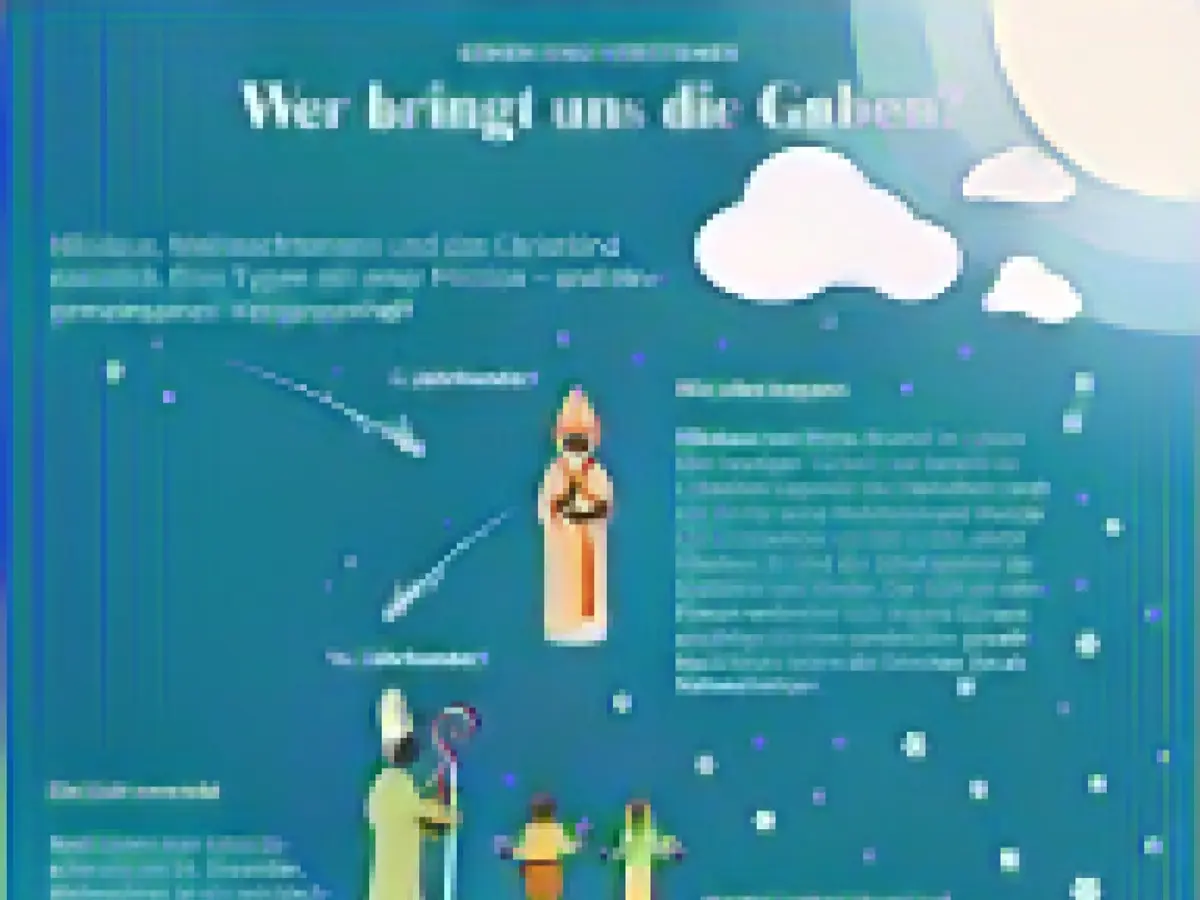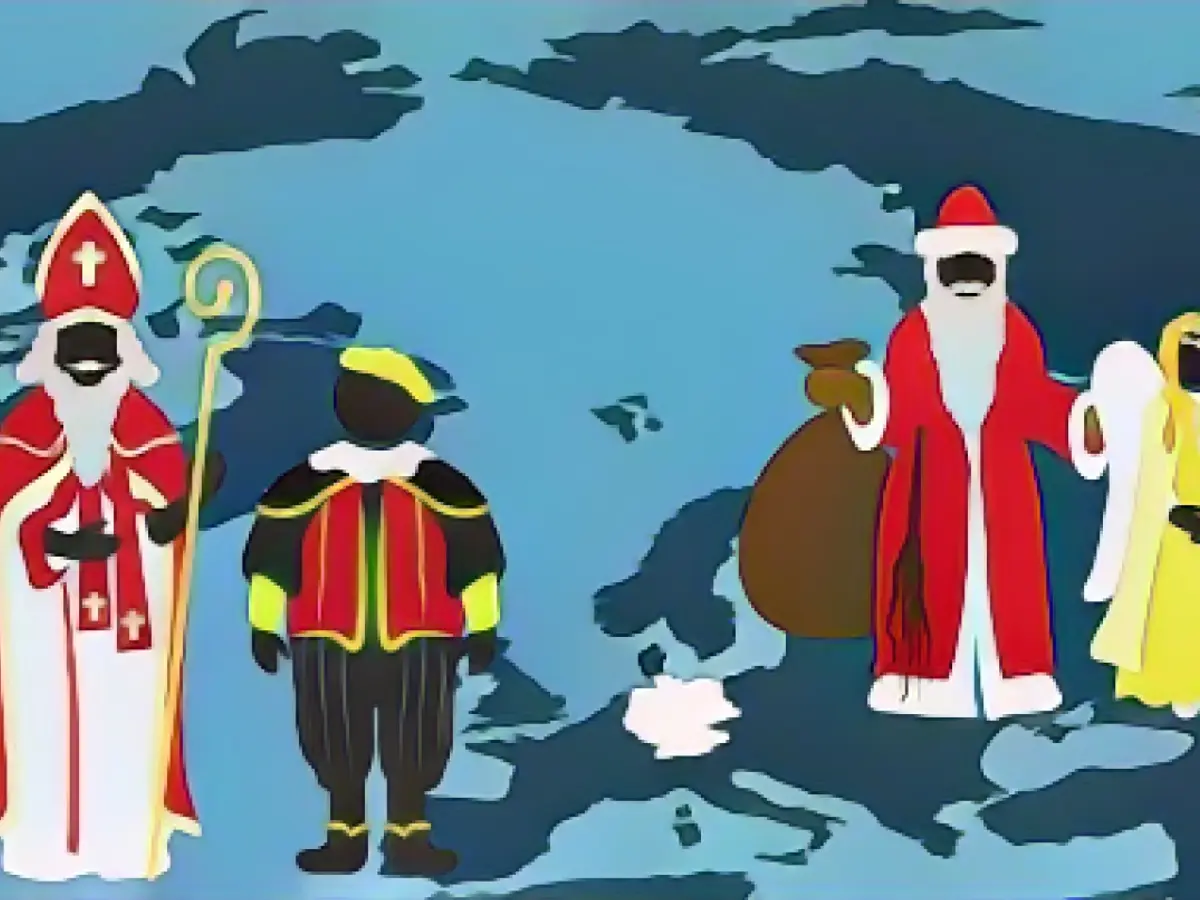For St. Nicholas Day - Santa Claus, Christkind, Santa Claus - who actually brings the gifts, where, when and why?
Santa Claus, Santa Claus and the Christ Child are three guys with a mission - and a shared past.
This has its origins in the fourth century: Nicholas of Myra, bishop in Lycia (modern-day Turkey), was already a legend during his lifetime: People revered Nicholas for his charitable deeds and miracles. Nicholas died on December 6 around 350 AD. He becomes the patron saint of sailors and children. The cult surrounding his person spreads throughout Europe; countless churches are dedicated to him. Even today, the Greeks celebrate him as their national saint.
In the 14th century, there was still no gift-giving on December 24; Christmas was a purely ecclesiastical festival. However, the custom of St. Nicholas developed around 1300. The bishop is regarded as the secret gift bringer for the children on December 6th. The new Christian cult mixed with old winter customs. In German cities, there are processions on St. Nicholas Day, with masked people in the entourage: Little angels, devils and pagan horrors.
Martin Luther clears the air and brings the Christ Child into play instead of St. Nicholas
For the 16th century reformer Martin Luther, the veneration of St. Nicholas was a "cynical thing". He demanded that only Christmas, i.e. the birth of the "Holy Christ", should be celebrated on December 25. In order for the children to still receive gifts, they should from now on receive them from the"Christ Child".
Luther's idea of the Christ Child initially only spread in Protestant countries, but later became popular in Catholic regions too. Nowadays, the Christ Child almost exclusively gives presents to children in Catholic regions, sometimes as the baby Jesus, sometimes as an angelic being with female features.
St. Nicholas also survives - and faces competition from Santa Claus
Despite Luther's criticism, the St. Nicholas custom lives on. What is new is the visit: As a benevolent bishop, St. Nicholas comes into homes and brings small gifts to the children. The pagan figures now appear at his side as punishing companions, their masks and names changing depending on the region: Knecht Ruprecht, Krampus, Hans Muff, Pelzprecht, Hans Trapp.
From the 18th century onwards, the characters of the gift-bringing figures gradually merged into a single figure: Santa Claus, who now brought presents to Protestants in particular. It was not until the 20th century that the image of the jovial, fat old man in a red and white robe - who still looks a lot like St. Nicholas - also became established in Germany.
Germany today: Santa Claus and Christkind share the job, St. Nicholas comes earlier
Like siblings, Santa Claus and Santa Claus now share their tasks along denominational lines: Santa Claus gives presents on Christmas Eve in the north and east, the Christ Child mainly in the south. Both are eagerly awaited. Santa Claus is the vanguard, so to speak, and in some places comes to the children as early as December 6, St. Nicholas Day.
St. Nicholas, the Christ Child, Santa Claus: You can find a clear overview of the history of the gift bringers in the large stern graphic below:

Netherlands: Sinterklaas and "Zwarter Piet"
Despite their Protestant culture, the Dutch hold on to their figure of St. Nicholas: Sinterklaas. Accompanied by the politically controversial "Zwarten Piet", he brings presents to children on the evening of December 5th. To this day, St. Nicholas Day is the highlight of the Christmas season and the main gift-giving day in the neighboring country. Because many prices fall afterwards, many Germans take the opportunity to buy their Christmas presents in the neighboring country.
USA: Santa Claus rushes down the chimney
The Dutch bring Sinterklaas to America, where he becomes popular as Santa Claus from the middle of the 19th century. A caricaturist of German origin draws him: cheerful, fat, with a big beard, later also in a red robe. Coca-Cola sends this image around the world in advertising campaigns. "Santa", rushing down the chimney on the night of December 25th, is now a fixture in living rooms around the world.
Russia: Father Frost arrives a few days later
Father Frost, a pagan and austere apparition who can freeze everything to ice, comes from ancient folklore, not from the tradition of St. Nicholas. From the middle of the 19th century, he appeared as a worthy grandfather in an icy blue robe. Initially rejected by the communists as a "capitalist", since the 1930s he has officially been something like the Soviet Santa Claus who brings gifts on New Year's Eve. Today he is accompanied by the Snow Maiden.
Lesen Sie auch:
Santa Claus' origins can be traced back to Nicholas of Myra, a bishop in Lycia, modern-day Turkey, who was revered for his charitable deeds and miracles. He is considered the patron saint of sailors and children in many parts of Europe.
Martin Luther, the 16th century reformer, criticized the veneration of Saint Nicholas and advocated for the Christ Child to be the gift-giver instead. His idea gained popularity in Protestant countries and later spread to Catholic regions as well.
Despite Luther's criticism, the Saint Nicholas custom continued to live on in Europe. Saint Nicholas now visits homes and brings small gifts to children, accompanied by pagan figures who serve as punishing companions.
From the 18th century, the characters of the gift-bringing figures began to merge into a single figure: Santa Claus, who brought presents to Protestants in particular. It was not until the 20th century that the image of the jovial, fat old man in a red and white robe became established in Germany.
Today, Santa Claus and the Christ Child share the gift-giving duties in Germany, with Santa Claus bringing presents on Christmas Eve in the north and east, and the Christ Child mainly in the south.
In Russia, Father Frost, a pagan figure who can freeze everything to ice, is the Soviet Santa Claus who brings gifts on New Year's Eve, accompanied by the Snow Maiden.
Source: www.stern.de







